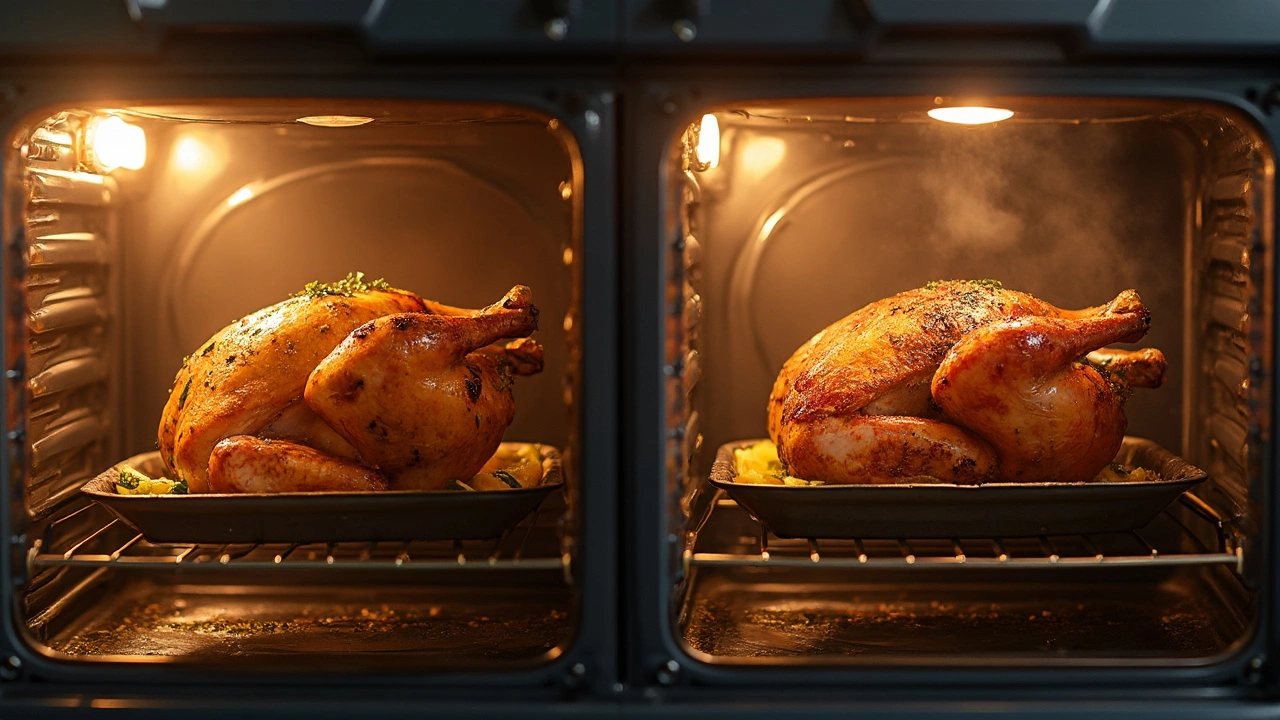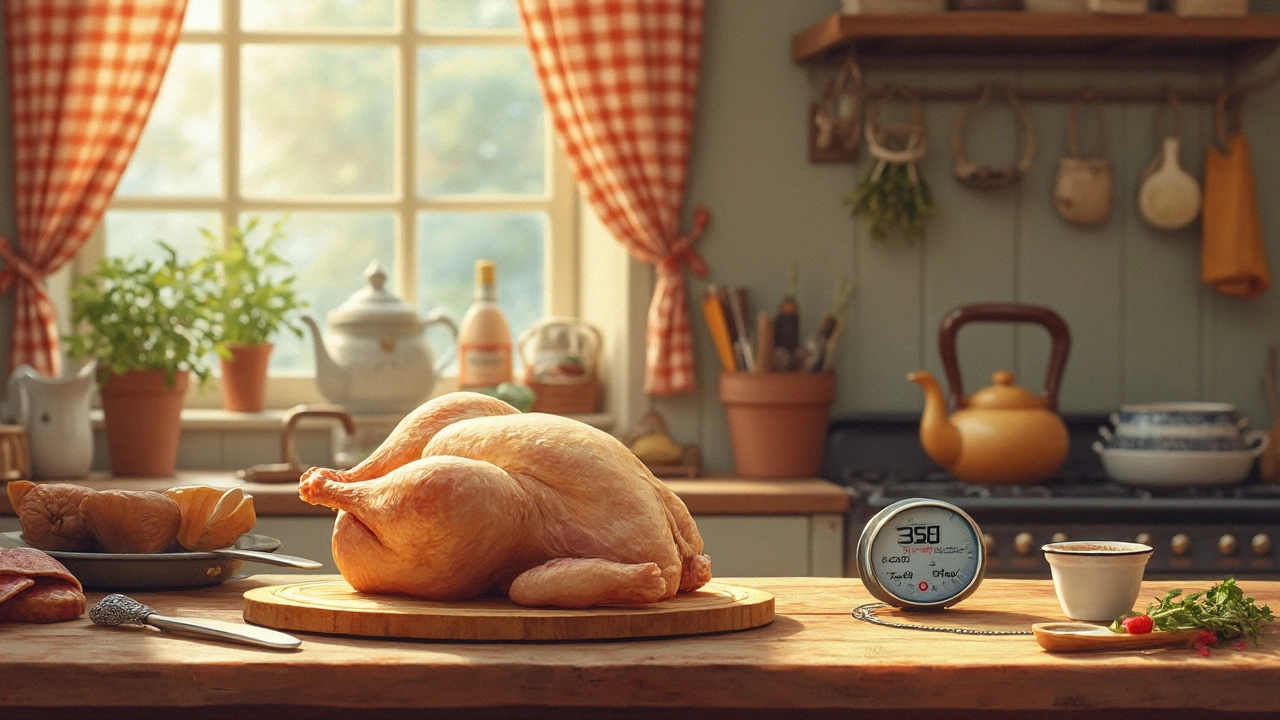When you're in the kitchen thinking about making a mouth-watering chicken dish, you might find yourself asking, 'Should I cook it at 350°F or 375°F?' Both temperatures are popular, but they can lead to different results. Making this choice isn't as simple as you might think!
For those who enjoy a tender, juicy chicken, sticking with 350°F might seem like the safer option. This lower temperature allows the meat to cook more evenly, helping to keep it from drying out. It's particularly great for larger cuts of chicken or whole birds that take longer to cook.
On the flip side, cranking up the oven to 375°F can create a deliciously crispy skin. This higher temperature promotes browning and can impart a wonderful, caramelized flavor. But be careful! It requires a watchful eye to prevent overcooking, especially with smaller pieces like chicken breasts.
- Understanding Cooking Temperatures
- Effects on Flavor and Texture
- Cooking Time Differences
- Practical Tips for Perfect Chicken
Understanding Cooking Temperatures
Alright, let's break it down: when cooking chicken, choosing the right temperature is more than just a number—it's about getting the texture and flavor you want. If you're after tender meat, then 350°F might be your best bet. Why? Because lower temperatures cook the meat gently, allowing the proteins to break down smoothly without losing too much moisture.
At 350°F, there's a bit more room for error, making it popular among folks who like to play it safe. Cooking at a lower temperature gives the meat time to cook evenly from the outside in, minimizing the risk of a dried-out drumstick.
But don't write off 375°F just yet. This slightly higher heat is perfect for those who crave crispy skin. It ramps up the Maillard reaction (that magical browning process), giving your chicken a golden, flavorful crust.
The USDA recommends cooking chicken to an internal temperature of 165°F, but getting there can look different depending on your oven settings. With modern ovens, it's good to use an oven thermometer to ensure accuracy, as oven dials aren't always precise. Remember, these temperatures apply to roasting or baking in the oven, not grilling or frying, which are whole different ball games!
Here's a little side note: If you're using convection settings, lower your set temperature by 25°F, since the air circulation can cook your chicken faster. So in a convection oven, you'd aim for 325°F or 350°F, respectively. Cool, right?
Effects on Flavor and Texture
The temperature you choose for cooking chicken really changes how your dish ends up tasting and feeling. Let's break it down to understand the key differences between 350°F and 375°F.
Cooking at 350°F
Cooking chicken at 350°F is all about gentleness. This temperature is often preferred if you're after super moist, tender chicken. The lower heat slowly coaxes out the natural juices, making each bite juicy. It's especially effective for larger cuts and roasts because it gives the meat time to cook evenly without rushing.
Another point worth mentioning is that this method is pretty forgiving. If you accidentally leave the chicken in a bit longer, it’s less likely to dry out compared to higher temperatures. For this reason, many home cooks consider it a safe bet—especially for big dinners where the meat is the star of the show.
Cooking at 375°F
Now, if you're aiming for a feast with crispy skin, 375°F can be your best friend. This increased heat promotes excellent browning on the outside while keeping the inside flavorful. You'll often find recipes suggesting this temperature for specific results, especially if a crispy, golden skin is what you crave.
There is, however, a slightly higher risk of drying out the chicken if not monitored properly, particularly for lean cuts like breasts. You'll need to keep an eye on cooking times to make sure the meat stays juicy inside. Timing and vigilance are crucial here to strike that perfect balance between crispy and juicy.
Making the Right Choice
Ultimately, the choice between 350°F and 375°F depends on your goal. Are you serving a juicy, tender main course or a dish with crispy, flavor-packed skin? Consider what suits your occasion best. Many chefs often start at a higher temperature to crisp up the skin then lower the heat to ensure the juices stay locked in, enjoying both worlds without compromise.

Cooking Time Differences
One of the most practical aspects to consider when choosing between cooking chicken at 350°F or 375°F is how long it takes. You want dinner on the table, after all! Let's break it down a bit.
Cooking at 350°F
If you're going for 350°F, expect a slower journey to flavorful chicken. This lower temperature works best for those who have a bit more time and desire fuller, juicier flavors. Typically, a whole bird might take about 20 minutes per pound. So, a 4-pound chicken would be looking at around 1 hour and 20 minutes, give or take.
Cooking at 375°F
Cranking the heat to 375°F speeds things up, perfect for when you're in a hurry. Many find this temp sweet to get that crispy skin while keeping the meat tender. A similar whole chicken will take around 15 minutes per pound. That same 4-pounder could be done in just about an hour, maybe a little more.
Now, for smaller cuts like chicken breasts or thighs, the cooking times differ too. For 350°F, boneless breasts might need about 25-30 minutes, while thighs would be closer to 35-40 minutes. At 375°F, you could shave off about 5-10 minutes for each.
| Chicken Cut | At 350°F | At 375°F |
|---|---|---|
| Whole Chicken (per pound) | 20 minutes | 15 minutes |
| Boneless Breasts | 25-30 minutes | 20-25 minutes |
| Thighs | 35-40 minutes | 30-35 minutes |
Always remember, these are rough guidelines. The best way to ensure perfectly cooked chicken? Invest in a meat thermometer. Aim for an internal temperature of about 165°F, and you'll avoid any unwanted surprises at dinnertime.
Practical Tips for Perfect Chicken
Cooking perfect chicken doesn't have to be rocket science, but it does pay to know a few tried-and-true tips. Whether you're choosing between cooking chicken at 350°F or 375°F, nailing down these basics can help you achieve the best results.
Use a Meat Thermometer
Never underestimate the power of a meat thermometer. It's your best friend for checking if your chicken has reached the safe internal temperature of 165°F without guessing. You'll avoid undercooked surprises or dried-out disasters. No thermometer? No problem—you can use the 'juices run clear' method as a backup, but a thermometer is more reliable.
Prepping the Chicken
Prep work matters a lot. Pat your chicken dry with a paper towel before seasoning it. This helps the skin crisp up, especially if you're going for that golden-brown finish at 375°F. Seasoning generously is key, too—don't be shy with your herbs and spices.
Resting After Cooking
Resting cooked chicken for at least 5-10 minutes allows juices to redistribute within the meat, keeping it moist and delicious. It's a small step that makes a big difference in how juicy your chicken turns out.
Chicken Cooking Time Chart
| Piece | Cooking Time at 350°F | Cooking Time at 375°F |
|---|---|---|
| Whole Chicken | 20 min per pound | 15-20 min per pound |
| Breasts | 30-35 minutes | 25-30 minutes |
| Thighs & Legs | 45-50 minutes | 40-45 minutes |
Adjust for Convection Ovens
If you're using a convection oven, adjust the temperature. Lower it by about 25°F, as these ovens cook more evenly and quickly. This means your chicken will still get that crispy texture without burning.
These simple pointers highlight that whether you're team cooking chicken at 350 or prefer a bit more heat at cooking chicken at 375, mastering these tips allows for a truly perfect meal every time.

